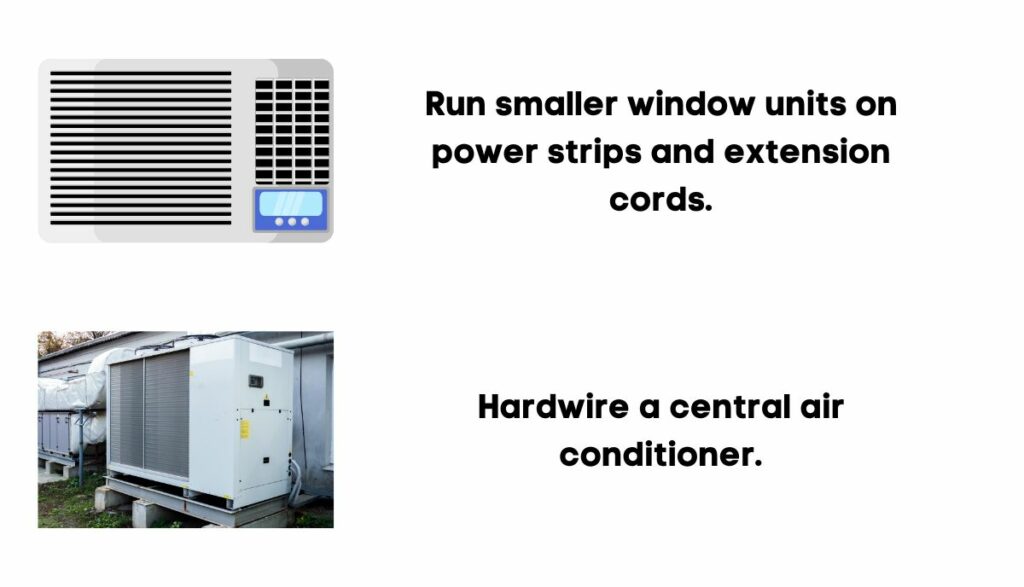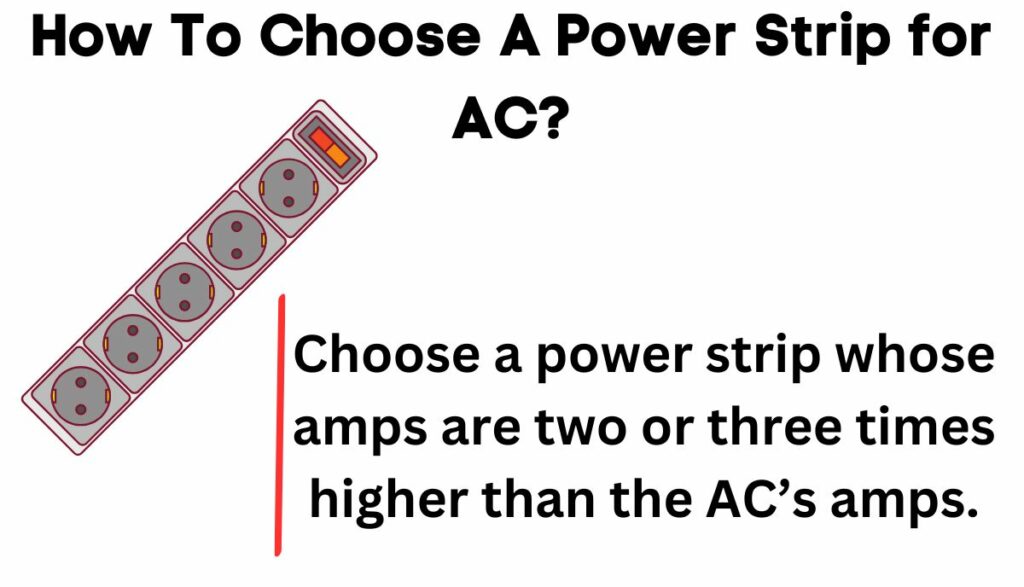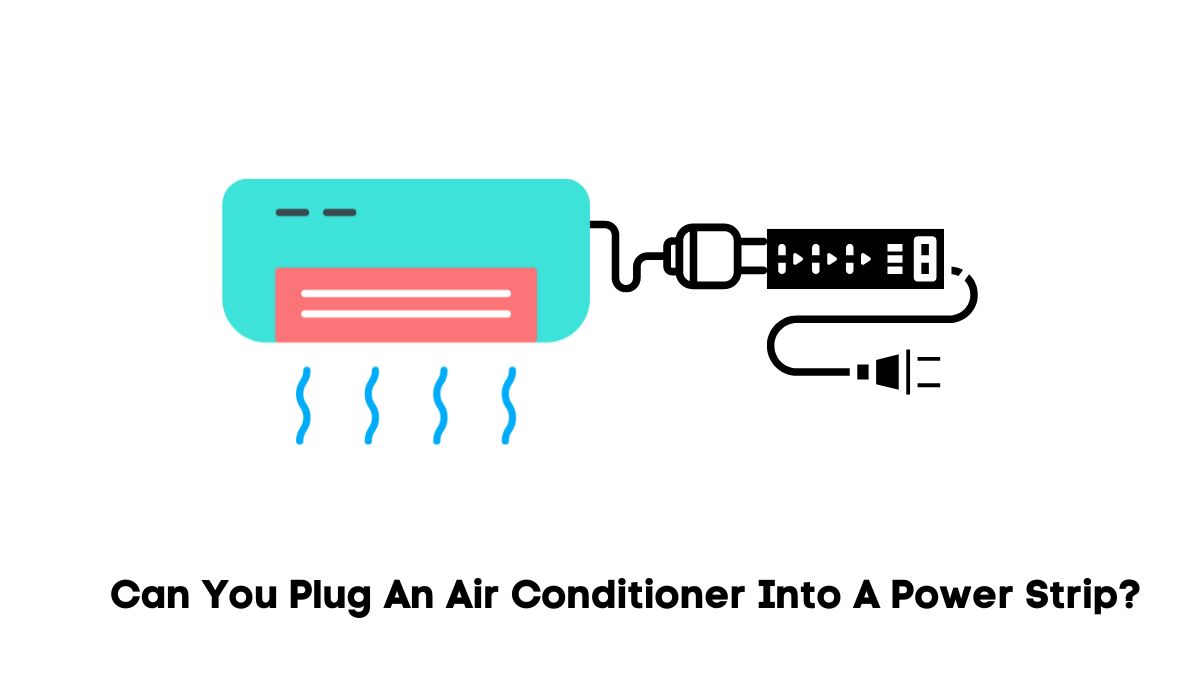Generally, air conditioners shouldn’t plug into power strips and extension cords. You have two major challenges:
- Power Consumption
Air conditioners use significant volumes of power. A study from “Universidad Carlos III de Madrid” found that residential air conditioning consumed one-third of Madrid’s power during peak electrical use in the summer.
Can you imagine what an air conditioner’s considerable power would do to a weak power strip? All power strips can overload. But that risk of overloading increases exponentially when you connect a heavy-duty appliance such as an air conditioner. You shouldn’t take the chance.
- Starting Wattage
Air conditioners cycle on and off multiple times throughout the day to maintain the temperature at the set threshold. An AC’s electrical draw increases when it cycles on. It may pull three or four times more power during those initial moments. This increases the risk of overloading. Experts don’t want you to take any chances.
Electrical Safety First has noticed that plugs in the UK have a 3A or 13A fuse. This makes the power strip less of a threat. But you should first confirm that your air conditioner uses a fused plug. You don’t want to rely on this tool to protect you when your air conditioner plug doesn’t include a fuse.
What Gauge Power Strip is Best For AC?
Most air conditioners run on conventional 15A and 20A circuits in residential settings. Therefore, any power strip with the same gauge as your home’s wiring will accommodate the air conditioner without overloading. You can’t go wrong with 12AWG. Although 14AWG can also meet your needs.
The air conditioner’s power consumption will shape your selection.
Things To Consider While Using Power Strip With Air Conditioner
How can you connect an AC unit to a power strip without starting a fire? You can lower the risks by taking the following factors into consideration:
1). What Is The Air Conditioner Type?
While ACs use a lot of power, some are more energy intensive than others. For instance, a central air conditioner can consume 5000 watts per usage hour because it uses ductwork to circulate air throughout your home.
Window units are smaller and consume 1500 watts or less, which is appealing. However, one-window AC is unlikely to cool a house. Each room needs a separate unit.
Ductless ACs are similar to central air conditioners. However, you can control the temperature in each room independently. The larger and more comprehensive the air conditioner, the more power it will consume.

While smaller window units can run on power strips and extension cords, you will hardwire a central air conditioner.
2). What Is The Air Conditioner’s Capacity?
The capacity is measured in BTU and directly ties into the air conditioner’s wattage. For instance, a 12,000 BTU AC can draw 9 amps. That figure jumps up to 12 amps for a 14,000 BTU unit.
The larger the air conditioner’s capacity, the more power it will pull, the higher the chances of an overload.
3). What is The Power Strip’s Capacity?

You find the AC’s wattage by looking at the nameplate. If the manufacturer omits the wattage, they will mention the BTU. Use this learn metrics calculator to convert the BTU into watts.
Once you know the wattage, convert the unit into amps. This will give you the rating to target when selecting a power strip. It is common practice to choose a power strip whose amps are two or three times higher than the AC’s amps.
This gives you room to breathe. Don’t forget that an AC’s electrical draw spikes when it cycles on. The starting watts are more important than the running wattage. If the power strips in your local store have only mentioned the gauge, use this Schneider Electric wire size chart to identify the ampacity associated with each gauge.
However, many manufacturers mention the gauge and amps. The power strip’s amps should always be higher than the air conditioner’s amps.
4). Does The Length Matter?
Because resistance increases with the length, you should buy the shortest power strip you can find. High resistance elevates the voltage drop, which, in turn, strains the compressor and motor. There’s a reason why heavy-duty appliances have short power cords. The manufacturers want to control the resistance and voltage drop.
How To Use AC With A Power Strip?
- Find the AC’s power requirements using the nameplate and manual.
- Find a power strip whose wattage exceeds the AC’s power requirements.
- Make sure the AC’s plug fits the power strip’s outlets. Don’t alter the AC plug because the prongs have a different configuration from the outlet slots. You can change the air conditioner’s power cord and plug or purchase a new power strip.
- I discourage you from using the power strip permanently. Use it for the few days or weeks it takes to install a wall outlet next to the air conditioner. Using a power strip over the long term increases the risks. As far as the Massachusetts Department of Fire Services is concerned, the wall outlet is the safest option.
- Don’t use damaged power strips. Replace them once you notice burn marks and tears on the cable.
- Don’t overload the power strip. It should only serve the AC. Fight the urge to connect fridges, toasters, and other heavy-duty appliances. Phones and e-cigarettes are too low-duty to make a difference. But you shouldn’t take chances with stronger devices. Even if the power strip can support them all, it can still catch fire when the air conditioner cycles on and its electrical draw spikes.
Best Power Strip For AC
This is a 220V 13A/1625W power strip with eight AC outlets and four USB ports. Boasting a six-foot cord, the device can work with 120V and 240V circuits. The USB ports use smart technology to adapt to the connected devices.
This allows the power strip to provide optimal charging speeds automatically. The GDT, TVS, and MOV surge protection circuits can absorb 2700 joules of energy. If you have doubts about the product’s claims, the power strip’s ETL and UL certification will put you at ease.
This power strip is the perfect answer to your prayers if surges are common in your area. It comes with a surge rating of 4,320 joules and $300,000 of equipment protection. Expect two USB ports (2.4 amps charging power), ten outlets, and a six-foot cord. The manufacturer has more than three decades of experience, which speaks volumes about the quality and reliability of this product.
This ETL-certified power strip has surge protection mechanisms that defend your air conditioner’s sensitive electronics from surges and spikes, including those that occur during stormy weather.
The device includes six smart outlets and a voice control function. The Kasa Smart app gives you remote control over the connected devices from any location. You can keep an eye on your equipment while on holiday.
This is a sturdy 125V extension cord with a compact, space-saving design that includes rotating outlets. The surge protection mechanism will stand between your equipment and lightning strikes and energy fluctuations.
The manufacturer’s $300,000 connected equipment warranty will cover you if things go wrong and you lose your appliances. With a 15A rating, you can trust the power strip to accommodate your air conditioner’s electrical requirements.

